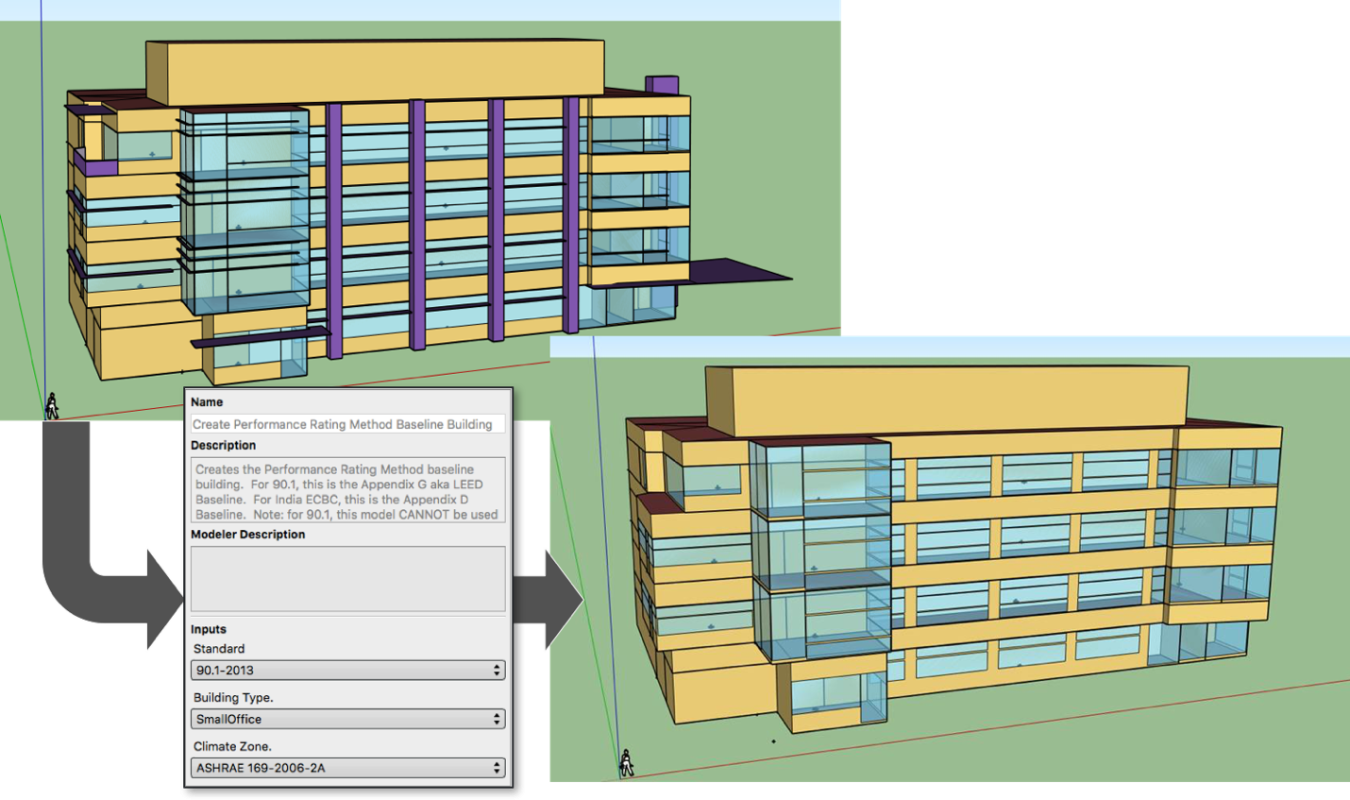
The new openstudio-standards Measure “Create Performance Rating Method Baseline Building” takes a model along with three arguments—code version, building type, and climate zone—and produces the corresponding ASHRAE 90.1 “Appendix G” baseline model. In this case, visible changes include removal of exterior shading and small changes in window area. Credit: Andrew Parker, NREL.
One of the unique and powerful features of BTO’s OpenStudio platform are Measures. Measures are Ruby scripts that are run on an OpenStudio energy model and simulation results to automate modeling tasks such as application of energy conservation measures, creating custom reports and visualizations or connecting EnergyPlus to other analysis tools. Measures can be downloaded from the Building Component Library (BCL) and installed manually. Measures and other Ruby programs are also available as installation packages called gems from rubygems.org.
One new gem that promises to be especially useful is openstudio-standards. The gem contains two Measures. The Create DOE Prototype Building takes three arguments: i) ASHRAE commercial building type (e.g., Medium Office, Full Service Restaurant), ii) ASHRAE climate zone (e.g., 1A-Miami, FL, 3C-San Francisco, CA), and iii) ASHRAE Standard 90.1 version (e.g., 2004, 2010) and creates an OpenStudio version of the corresponding commercial building prototype model.
Originally developed by Lawrence Berkley National Lab (LBNL), National Renewable Energy Lab (NREL), and Pacific Northwest National Lab (PNNL) under the name commercial building reference models, the models were adopted by PNNL’s energy codes team and adapted for use in code update development. PNNL releases a new batch of commercial building prototype models representing each new ASHRAE Standard 90.1 and IECC edition. Each batch includes an EnergyPlus model for each of 16 commercial building types in each of 17 ASHRAE climate zones. The models used them to create tools such as the Advanced Energy Design and Retrofit Guides, 179D tax credit easy calculator, Asset Score, and Scout. Other users and uses include New York state “stretch” energy code and the New Buildings Institute (NBI) Advanced Building New Construction Guide. OpenStudio Models are more flexible and powerful than EnergyPlus models. They include convenient abstractions such as spaces and space-types that are not present in EnergyPlus. And they are “first-class citizens” of the OpenStudio ecosystem and can take full advantage of its capabilities—most significantly, they can be transformed using Measures. OpenStudio versions of the prototype models open up greater analysis possibilities.
“Having the prototype building models available in OpenStudio will enable organizations outside of the National Lab System to easily perform thorough, portfolio scale impact analysis of a large number of energy conservation measures,” says NREL’s Andrew Parker, the gem’s first author.
The second Measure in the openstudio-standards gem uses the same underlying functions in a slightly different way. Create Performance Rating Method Baseline Building takes building type, climate zone, and vintage arguments and an OpenStudio Model and creates the corresponding ASHRAE 90.1 Performance Rating Method “Appendix G” baseline. It is this specific functionality that promises to deliver modeler productivity while improving model consistency. Baseline model generation is a key part of many applications including code-compliance, green certification, and performance documentation for utility incentive programs. It is also a mechanical, uncreative task that is vulnerable to both unintentional errors and intentional “cheating.” Automating baseline generation eliminates not only errors, but also tedium, allowing modelers to spend more time—and project budget—evaluating energy-efficiency design and operation strategies.
The openstudio-standards gem is still a work in progress, but much of the functionality is already in place. BTO will continue to refine the existing models and baselining procedures, add 90.1-2016 “Addendum BM” baselining capabilities—supporting LEED v4—as well as prototype models for supermarkets and data centers. The use of a spreadsheet to store the many data tables that are associated with standards—insulation values, equipment efficiencies, etc.—makes it easy to adapt openstudio-standards to other ASHRAE-like code frameworks. Both Canada and India are using openstudio-standards to automate baseline generation for their respective national energy-efficiency codes.
“Natural Resources Canada has incorporated the Canadian National Energy Code for Buildings (NECB) 2011 standards support into OpenStudio Standards. We believe that this will help the development of energy policies and codes and with the assessment of technologies in Canada,” says Phylroy Lopez, projects leader for housing and buildings at NRCan research organization CanmetENERGY. “OpenStudio has become a cornerstone in our commercial buildings research here.”

